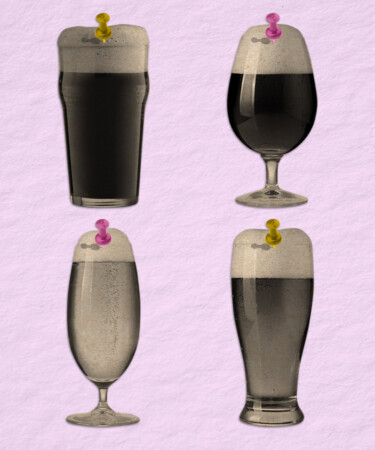There is a multitude of things to consider when ordering a brew at your local watering hole. From the style of beer, to the techniques used to brew it, to the temperature at which the beer is served and the angle at which it’s poured, there’s more to a sudsy pint than meets the eye. To complicate matters further, when it comes to the glasses your favorite brews are served in, not all are created equally.
While the pint glass may be the tried-and-true standard, there are many vessels designed to have unique effects on the beers poured into them. With over 20 shapes to choose from, you may find yourself questioning whether or not a glass can actually impact the profile of a brew. To discover why some styles of beer are poured into certain glasses, and to uncover how this impacts flavor, VinePair spoke with Mark Graves, procurement manager of Cape May Brewing Co., to learn more.
“Different shapes and sizes of glassware can definitely affect how a beer tastes and smells,” Graves explains. “For many people, bars, and restaurants, the most familiar glass to them is probably the pint glass as they are very easy to stack and clean. While the pint glass is a fine glass, it neither hurts nor enhances the aroma or taste of the beer.”
Take, for example, the tulip glass, markedly different from the pint glass due to its stem and bulbous base concaving inward. The shape of the tulip glass functions to capture flavor and aromas in the body of the glass, pushing them toward the top of the glass. “Similarly to wine glasses, the stemmed base promotes swirling to agitate some flavors upward,” Grave notes. He explains that a tulip glass is a perfect entry point for beer lovers looking to explore glassware beyond the classic pint. “This kind of glass is great for Belgian beers, complex beers that are high in alcohol, and dark beers like stouts and porters,” he says. “Tulips are also a fine glass choice for some IPAs and saisons.”
Another glass to experiment with is a pilsner glass, recognizable for its tall, thin shape. Pilsners tend to be highly carbonated beers, and Graves notes that the eponymous glass is made to showcase this fact. Like a Champagne flute, with a straight incline from bottom to top, the pilsner glass functions to concentrate carbonation into a head at the top of the glass. “Old World styles of lager typically use softer, more floral hops, so this type of glass does a great job of emphasizing that aroma,” he says. “Pilsners, American blonde ales, and other highly carbonated brews are going to do really well with this type of glass.”
When it comes to iconic stein and dimpled mugs, which are often seen in German biergartens and are widely circulated at Oktoberfest, their purpose goes beyond aesthetics. Their size allows them to hold larger pours, and their thick glass walls help insulate a brew from the warmth of your hands, thus making them more suitable for drinking out of on warm days or over longer periods of time.
While there is a multitude of glass options out there for your favorite beers, Graves stresses that choosing the proper glass doesn’t have to be a stuffy or strict chore. “Personally, I have my glasses I use more often, like a Belgian-style tulip, a lager glass, and a pint glass,” he says. “The more I drink as I get older, the more I like to keep it simple.” No matter the glass you’re sipping from, Graves highlights the importance of using proper technique when pouring the beer as to avoid losing any flavors or aromas. “Grab a clean glass and turn it at a roughly 45-degree angle, pouring the beer gently down the edge of the glass,” he instructs. “Pour it this way until you’re about half to two-thirds of the way up the glass before slowly tilting it back to level and pouring into the center of the glass to get the right level of foam. Foam protects the aroma and flavors within the glass, while also dispersing them evenly.” Pour any other way, he says, and you’ll end up with a “foamy mess.”
If you are looking to experiment with various glass types and are curious to explore the differences yourself, Graves suggests grabbing a tulip glass and a pint glass and pouring the same beer into each. Sit with both and explore how each smells, and note whether or not you notice any differences in taste or appearance. He notes that sometimes, a classic pint will be the best option, but sometimes it won’t. The only way to determine for sure is by experimenting for yourself.
